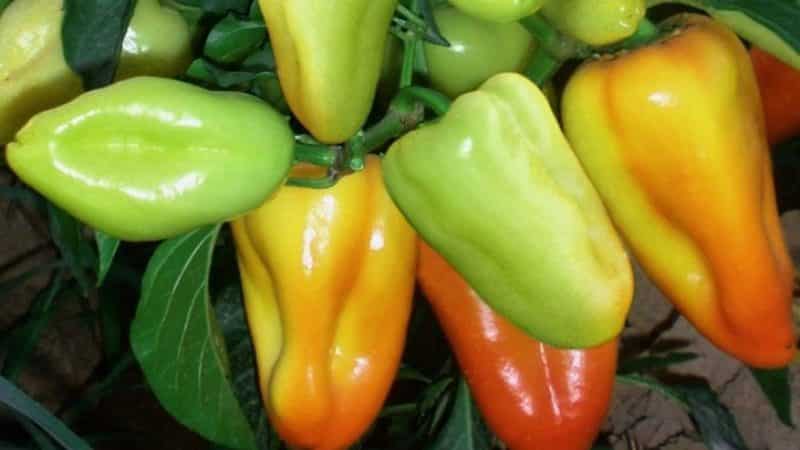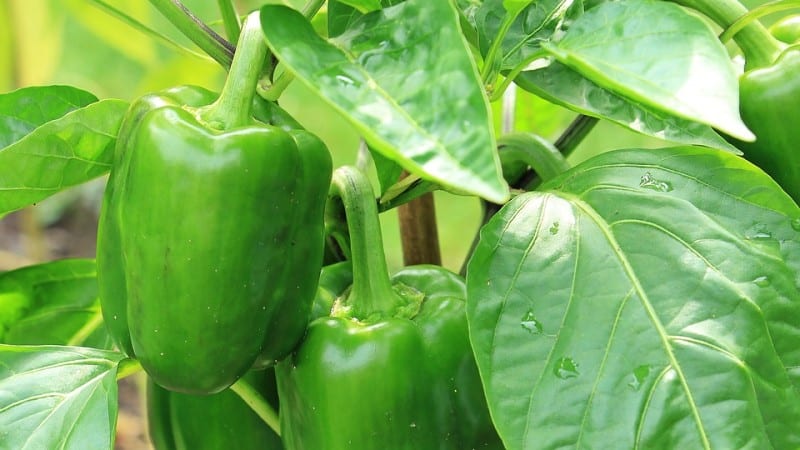Why peppers don’t turn red in a greenhouse: find out the reason and speed up ripening
At the stage of biological ripeness, bell pepper has excellent taste. The vegetable is used fresh and for canning. It can be grown in greenhouse conditions and in garden beds.
It happens that the development of a crop slows down and the fruits do not acquire the desired color on time. From the article you will learn why peppers do not turn red in a greenhouse and how you can speed up their ripening.
Why do peppers not turn red in a greenhouse or greenhouse?
Sweet peppers may not turn red if the vegetables for seed selection were purchased at the supermarket. Typically, large-fruited peppers with thick walls and high yields are on the shelves. They are brought from countries with warm climates and long summers. The ripening period for such peppers is late.
 In most of the post-Soviet space, climatic conditions are not suitable for growing store-bought peppers, as they will not have enough sunlight to fully ripen and turn red.
In most of the post-Soviet space, climatic conditions are not suitable for growing store-bought peppers, as they will not have enough sunlight to fully ripen and turn red.
Reference. On the bag of seeds, the manufacturer writes the terms of technical ripening of sweet peppers - the period when the vegetable is poured. Pepper coloring occurs during biological maturation. Up to 30 days pass between these stages.
Southern culture is sensitive to any changes in weather conditions. During cold weather or drought, the plant may completely shed its foliage and ovaries, refusing to bear fruit. The following are factors that can significantly affect the ripening of bell peppers.
Feature of the variety
Before sowing seeds, you need to make sure that the variety is chosen correctly. bell pepper may have a rich green, orange, red or yellow color when ripe.
Residents of the middle zone and northern latitudes have adapted to growing very early and early pepper varieties. Late-ripening crops are suitable for southern territories. The best choice for temperate and cool climates are hybrids. They tolerate light frosts well, are resistant to many diseases, and have excellent taste.
Lack of nutrients in the soil
Pepper is a demanding crop regarding the presence of calcium in the soil. You can compensate for its deficiency using wood ash. The mineral is useful for pepper at any stage of development.
 Southern culture does not tolerate clay soil well. Sandy loam, light soil, enriched with biological humus, is an ideal choice for growing sweet peppers. You should not allow an excess of nitrogen compounds: this will negatively affect the yield and increase the green mass.
Southern culture does not tolerate clay soil well. Sandy loam, light soil, enriched with biological humus, is an ideal choice for growing sweet peppers. You should not allow an excess of nitrogen compounds: this will negatively affect the yield and increase the green mass.
It is recommended to feed the plant every 14-16 days. Organic and mineral complexes are suitable for enriching the soil. At the moment of fruit formation, you need to add phosphorus to the fertilizing, and to prevent the pepper from rotting - calcium, calcium nitrate (2-3 times during the entire growing season is enough).
Not enough heat
Bell pepper is a heat-loving crop. At low air temperatures, its fruits acquire a dark shade. As a rule, this happens if the temperature drops below 15°C.
To preserve the crop in cool weather, it is recommended to cover the plantings at night with any covering material; this will help the plant not to freeze. In greenhouse conditions it is much easier to regulate the temperature than outside.Not far from the plants, containers with heated water are placed or stones heated in a fire are placed along the paths.
A comfortable temperature for the development of bell pepper is within 25-30°C during the daytime, at night – not lower than 18-20°C, otherwise the ovary will begin to fall off.
Attention! Air overheating above 35-37°C is also dangerous for peppers. In this case, due to dry air and dry soil, the plant withers. Drafts are also harmful to pepper.
Not enough lighting
Paradoxically, too much sunlight can only harm the plant. Pepper is a short-day crop. You will get improved yield performance by providing the plant with about 12 hours of daylight.
Foliage and fruits should evenly receive ultraviolet radiation in the required volume. This will help the plant form, mature and turn into its natural color. In the shade, the crop stretches out and forms few ovaries. According to gardeners, this situation can be corrected by installing a reflective screen. It will reflect the light on the sweet pepper.
A tall plant is placed in the center of the bed, and a low-growing plant is placed on the sides. If the plant grows in a greenhouse, the coating must be highly transmittable to ultraviolet rays.
Attention! To ensure intense light flow inside the polycarbonate greenhouse, a reflective screen or devices with ultraviolet reflection are installed.
Planting too thick

If the bell pepper plantings become too thick, the soil will begin to deplete quickly. Seedlings growing close to each other shade each other, so the light falls unevenly on the seedlings.
When planting crops, maintain distance between rows. It is 60-70 cm. In a row, tall seedlings are planted at a distance of 35-40 cm, low-growing varieties - 30 cm.
Important! With compacted plantings, soil moisture increases, which can lead to root rot or disease.
Too much ovary
If a lot of ovary forms on the bush, then the vegetables do not always have time to fully fill to the desired size and color. Therefore, it is recommended to remove the first inflorescence, which is located in the branching area of the stem. The name of such a flower is crown.
In some cases, several crown inflorescences may form. If you want to get high-quality fruits, be sure to pinch them. If this is not done, the crop will begin to grow new branches, and all the strength will go not to the formation of the ovary, but to the green mass. Only a strong bud is left in the internodes.
You should not leave a lot of ovaries on the plant, otherwise the fruits will be small and biological ripeness will slow down. The optimal amount for a tall pepper bush is 17-25 ovaries.
Eliminating the causes
No matter what climatic conditions the bell pepper grows in, it requires proper care for full ripening. Let's look at how to correct the situation when the fruits do not turn red:
- In the greenhouse, close the doors and windows at night. Additionally, you can use agrofibre.
- Install heat accumulators between rows of plantings. These can be containers with heated water, heated stones or bricks. During the day they will be heated by the sun's rays, and at night they will give off heat to the plants.
- Strictly monitor soil moisture. It should be slightly damp. Avoid overwatering.
- Do not feed the crop fertilizer with nitrogen. During the fruiting period, it will be enough to add 1-2 tbsp of wood ash under the bushes. l., phosphorus and potassium.
When planting this vegetable, the main condition for obtaining high yields is good quality seeds. In most areas of the country, it is better to use ultra-early or early ripening varieties. Mid-season crops are suitable for greenhouse conditions.
How to make peppers ripen
According to experienced gardeners, sweet peppers should not be kept on the bush and wait until they are fully ripe. The fruits are removed when they become shiny and have thick walls. You can wait for new buds, but you don’t need to wait too long. By this moment, the fruit has already managed to accumulate all the nutritional elements necessary for full ripening.

Life hacks from experienced farmers
After the first harvest, bell peppers continue to bear fruit and turn red. If the color does not appear for a long time, you can try to speed up this process using traditional methods.
A few secrets:
- Place banana peels under the bushes.
- Be sure to pinch the first four flowers. The plant only benefits from this, since the first inflorescences from the mother bush draw a lot of juices.
- To make sweet peppers turn red or yellow faster, the fruits are picked and placed in wooden boxes along with apples and ripened tomatoes. The boxes are covered on top. Redness will occur in a matter of days. This is explained by the fact that ripening vegetables release ethylene. It is he who affects the pepper fruits. Thus, a chain reaction is started.
Read also:
how to salt whole bell peppers for the winter quickly and tasty.
Where and how to store bell peppers for the winter.
The benefits and harms of green bell peppers for the health of women, men and children.
Conclusion
Despite the fact that bell pepper is considered a capricious and demanding crop, methods for growing it are available to everyone. To obtain good yield results, adhere to the rules of agricultural technology and use the advice of experienced gardeners who know how to speed up the ripening process of peppers.